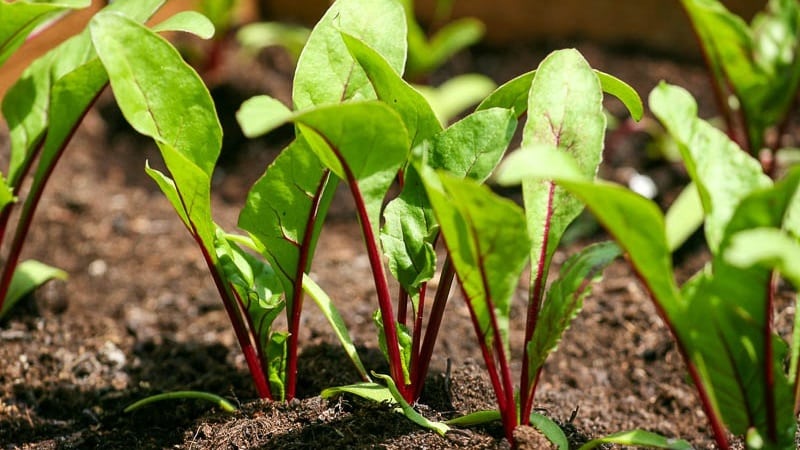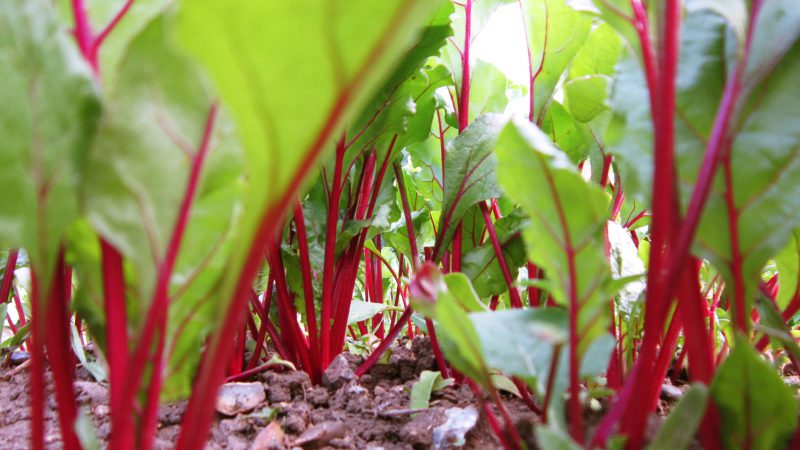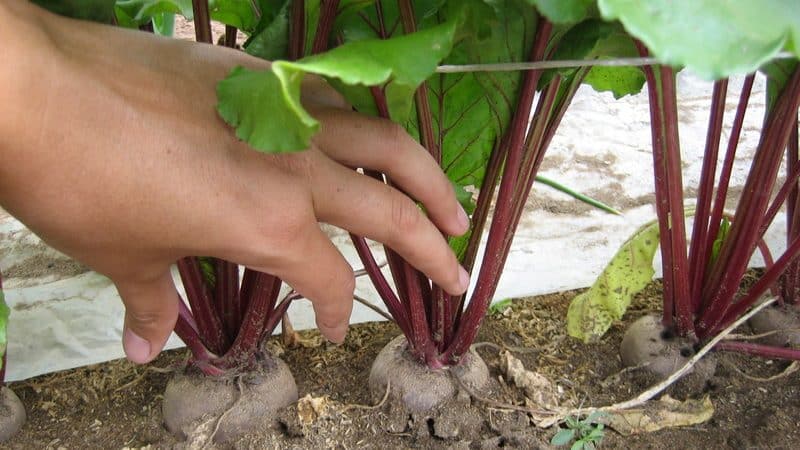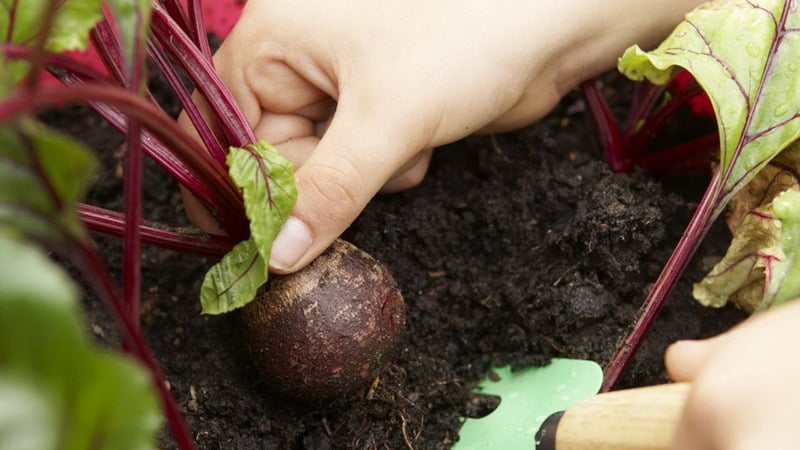Beetroot grows poorly - how to feed it: determine the lack of microelements and select the best fertilizer composition
Beetroot is a common vegetable crop that grows in almost every garden. For experienced gardeners, the root crop grows large and sweet. But what if the beets don't grow? In this article we will talk in detail about the rules for caring for beets and the best fertilizers for them.
Why beets grow poorly
To get a good beet harvest, you need to follow the rules of planting, care and feeding. When planting, choose well-lit places on the site, and make the sides of the beds high enough. But it happens that even when these conditions are met, the seedlings grow poorly, the plants look stunted, and the fruits are small and tasteless.
How to determine which microelements are missing

A lack of microelements in the soil can significantly affect the quality and quantity of the beet harvest.
It is not difficult to determine what substances a vegetable lacks for normal formation. To do this, pay attention to the condition of the tops and roots:
- yellow spots on the foliage indicate potassium deficiency;
- too much red tops indicates a lack of sodium;
- weak, underdeveloped leaves are a sign of nitrogen deficiency;
- Rotting of the beet core is a clear sign that boron should be added to the soil.
How to feed beets
To fertilize beet plantings, both organic and chemical fertilizers are used.
Organic ones include:
- infusions of plants with the addition of yeast;
- mullein;
- bird droppings.
The most popular chemical drugs are:
- potassium sulfate;
- superphosphate;
- ammonium nitrate.
Purchased ready-made minerals

There are dozens of types of ready-made mineral fertilizers for fertilizing root crops; they can be complex or single-component. Let's look at the most popular and effective preparations among experienced gardeners.
"Bordeaux"
A complex product that not only supplies beets with all the substances necessary for full growth, but also protects them from dangerous diseases of cultivated plants. Bordeaux contains trace elements: potassium - 18%, phosphorus - 16%, nitrogen - 13%.
This fertilizer is used both to saturate the soil with useful substances before planting and for the first fertilizing. It is used both in dry form and as a solution. “Bordeaux” increases productivity, improves the appearance of root crops and taste. No other fertilizers are required when using this product.
"NPK Complex"
For greater effectiveness, this drug is recommended to be used in combination with nitroammophoska. When used, the components are diluted in equal parts.
The complex is most suitable for fertilizing the soil before planting beets. First, they dig up the ridge, then spread the fertilizer evenly over its entire surface and carefully level it with a rake. The final stage of processing will be watering. It is recommended to use fertilizer at least 5 days before planting the seeds.
Ammonium nitrate
The drug saturates the soil with nitrogen and is used for the first feeding of the plant when mass shoots appear. The fertilizer is carefully diluted in 10 liters of water and applied not at the root, but in the furrows between the plants.
Folk remedies
Natural fertilizers are considered no less effective than ready-made commercial preparations. Such products are applied to the soil in autumn, spring and throughout the summer. To saturate the soil with useful substances, mullein, compost and humus are added to it before planting and after harvesting.
Important! It is not recommended to apply fresh manure to the ridges, as it oversaturates the soil and can cause underdevelopment and deformation of the fruits.
Chicken droppings and mullein
An infusion of chicken droppings or mullein will saturate the soil with nitrogen. Ideal for the first feeding of root crops. It is not recommended to apply it directly to the root. It is best to fill the furrows with it between plantings.
When preparing the solution, use the following concentrations: for mullein - 1:8, for chicken manure - 1:12. Most of it is water. Do not exceed the specified standards, as you can burn the roots of the plant.
Ash

Suitable for second feeding. Used both dry and diluted in water. For the norm, 1 glass per 1 m2 is enough.
Infusion of herbs and weeds
Chop the herbs and add warm water. Let it steep in warm water for several days until the infusion turns light brown. Beets should be fertilized with it every 10 days.
Yeast
Yeast supplement is prepared as follows: 25 g of the product are diluted in 10 liters of water, infused for at least 2 hours. Plants can be watered with this solution once every 10 days.
Salt
Watering with salt water is carried out both to improve the taste of beets (they become sweeter) and to saturate the fruit with necessary microelements.
Complementary feeding scheme
Fertilizers for beets are used in several stages per season. The maximum break between fertilizing is 15 days, the last application is possible 20 days before harvest.
First feeding
Before applying fertilizer, thin out the plantings and make furrows between them.
The following solutions are used:
- ammonium nitrate—30 g per 10 liters of water;
- mullein - 1 kg per 10 liters of water;
- bird droppings - 1 kg per 15 liters of water.
After application, loosen the soil between the rows.
Second feeding
The second application of fertilizer to the soil during the season occurs during the period when fruit formation begins. Only required if there is a nitrogen deficiency. To do this, prepare the following solution: 40 g of potassium sulfur and superphosphate are carefully diluted in 10 liters of water. The solution consumption is 10 linear meters.
Third feeding
It is recommended to do 20-30 days before harvest. This helps to fill the root crops and improve their quality.
In this case, the dry method is used:
- potassium nitrate: 50 g per 1 m2;
- magnesium sulfate or potassium magnesium: 20 g per 1 m2.
If there is a lack of boron in the soil, a solution of boric acid is used in the proportions of 2.5 g of powder per 10 liters of water.
Instructions for feeding beets

Beets respond positively to fertilization. The main thing is not to oversaturate the soil and burn the roots. It is recommended to strictly follow the proportions when preparing solutions.
Important! You cannot apply drugs directly to the root; it is better to make shallow furrows between the rows before starting watering.
Whenever feeding, follow the following rules:
- the first is carried out when 2 full-fledged leaves;
- the second - after the tops close;
- the third - when the root crop appears above the ground;
- The fourth feeding is carried out in case of emergency, 15 days after the third.
The nuances of fertilizing in the greenhouse and on the open ground
Growing beets in a greenhouse and in open ground is different from each other, so care will be different.The main difference is that fertilizing in the greenhouse is carried out less frequently, and it is necessary to maintain normal humidity. Since the soil in a greenhouse dries out quickly and retains nutrients longer than in an open place.
Root and foliar feeding
Root fertilizing is used less frequently than foliar fertilizing, since the second type of fertilization is considered more effective.
For root feeding, phosphorus and potassium fertilizers, solutions of salt and boric acid are used. The interval between them is at least 15 days.
Foliar feeding has the following advantages:
- can be done at any time;
- overdose is excluded;
- minerals are absorbed by the vegetable faster.
Advice from experienced gardeners

To grow tasty beets and reap a rich harvest, listen to the advice of experienced gardeners. When growing this root vegetable they recommend:
- do not neglect the application of fertilizers in open ground;
- administer medications only after glaze;
- immediately after planting, apply fertilizers containing nitrogen;
- carefully monitor the condition of the tops and, at the slightest change in their appearance, feed with appropriate compounds.
Conclusion
Proper care of beet plantings will provide even a novice gardener with a bountiful harvest. The main thing is to follow the fertilizer application schedules and proportions when preparing them, monitor the condition of the root crops and promptly respond to all external changes.